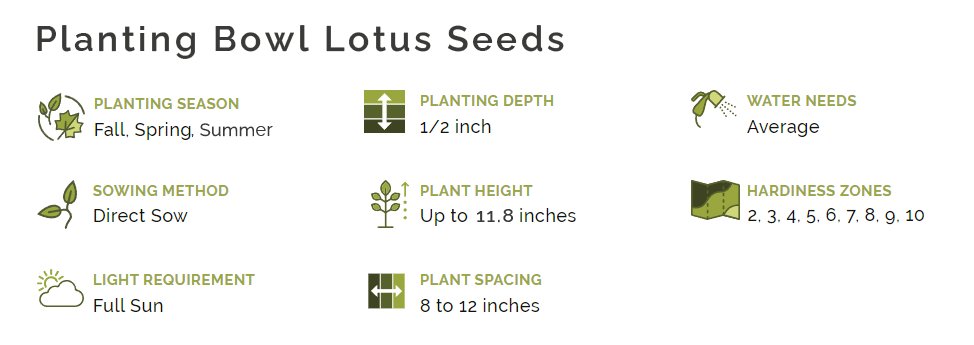Bowl Lotus seeds, nature's serene marvels. These seeds sprout into delicate lotus flowers, evoking a sense of tranquility and Zen. Perfect for indoor spaces and study rooms, they create an atmosphere conducive to learning. Immerse yourself in the beauty of these petite lotus blooms, bringing a touch of serenity to your surroundings.
![]()
When to Plant Bowl Lotus Seeds
Bowl Lotus seeds can be planted in spring, summer, or early fall. These stunning flowers typically thrive in warmer soil and temperatures, which help stimulate their growth and blooming. Additionally, they require a good amount of sunlight.
Where to Plant Bowl Lotus Seeds
Bowl Lotus thrives with a minimum of 4-5 hours of abundant sunlight per day. It's best to place them in a sunny study room or on a well-lit balcony. Once the sunlight requirement is met, they can flourish in full sun or any shady spot inside your home.
How to Plant Bowl Lotus Seeds
If you're an experienced gardener, you can opt for hydroponic cultivation directly in water. However, for beginners, it's recommended to purchase some pond soil or riverbed soil. These soils are rich in organic matter and provide proper drainage and nutrient supply. When starting out, fill your container halfway with the soil. This allows enough space for the Bowl Lotus to grow and establish its roots.
Must read
-
Soaking Seed Considerations: For soaking the seeds, it's best to do it between May and August as they are more likely to bloom. If they don't bloom, you can try repotting them the following year. In the southern regions, start soaking around May 1st, and in the northern regions, around June 1st (soaking too early may result in slower growth and damage due to unstable temperatures). First, use disposable cups or bowls to soak the seeds. Second, use clean water only, and avoid adding any miscellaneous items. The water depth should be around 8 to 10 centimeters. Third, place the seeds in a location with ample sunlight (avoid direct exposure if the temperature exceeds 30 degrees Celsius, just ensure good light). Fourth, before germination, change the water twice a day (morning and evening). After germination, changing the water once every three to five days is sufficient, until the roots reach about two centimeters and the leaves have sprouted. At that point, you can prepare the pot and soil for transplanting. Avoid planting without developed roots and leaves.
-
Container: Choose a container with a diameter of around 25 centimeters and a height of 10-20 centimeters. For soil, use a mixture of pond mud, garden soil, and aquatic plant mud. Mix more than half of the pot with water to create a mud-like consistency.
-
Fertilization: Do not fertilize initially. Once the plant has more than six leaves, start fertilizing. Adjust the amount of fertilizer based on the number of leaves and pot size. Apply fertilizer every 10 days, but not more than 10 granules per application.
-
Mosquitoes in the water can be controlled by adding a small amount of mosquito repellent (pyrethrin) or a piece of mosquito coil. Another option is to keep small snails or mosquito fish (Gambusia) in the water. This will help keep the water clear and reduce mosquito presence.
How to Care for Bowl Lotus
-
Water quality and level: Bowl Lotus prefers clear water, so it's recommended to use filtered or purified water. Maintain an appropriate water level to keep the plant's roots submerged.
-
Lighting: Bowl Lotus requires ample sunlight for growth and blooming. Place it in an area that receives at least 4-5 hours of direct sunlight each day.
-
Temperature: Bowl Lotus thrives in warm climates, with the optimal growth temperature range being between 20-30 degrees Celsius (68-86 degrees Fahrenheit). Avoid extreme cold or hot environments.
-
Nutrients: Providing an adequate supply of nutrients is important for Bowl Lotus. You can use aquatic plant fertilizers suitable for water plants and add them in the recommended amounts according to the package instructions.
-
Avoid over-fertilizing: Over-fertilizing can lead to water quality issues and excessive plant growth. Follow the instructions for fertilizer usage and regularly change the water.
-
Pest and disease control: Keeping the water clean helps reduce the occurrence of pests and diseases. If any issues arise, take appropriate measures such as using suitable insecticides or treatments.
-
Regular pruning: Periodic pruning helps control plant growth and shape, and encourages more flower bud development.


















